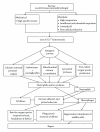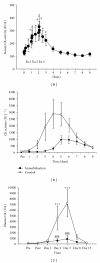Creatine-kinase- and exercise-related muscle damage implications for muscle performance and recovery
- PMID: 22288008
- PMCID: PMC3263635
- DOI: 10.1155/2012/960363
Creatine-kinase- and exercise-related muscle damage implications for muscle performance and recovery
Abstract
The appearance of creatine kinase (CK) in blood has been generally considered to be an indirect marker of muscle damage, particularly for diagnosis of medical conditions such as myocardial infarction, muscular dystrophy, and cerebral diseases. However, there is controversy in the literature concerning its validity in reflecting muscle damage as a consequence of level and intensity of physical exercise. Nonmodifiable factors, for example, ethnicity, age, and gender, can also affect enzyme tissue activity and subsequent CK serum levels. The extent of effect suggests that acceptable upper limits of normal CK levels may need to be reset to recognise the impact of these factors. There is a need for standardisation of protocols and stronger guidelines which would facilitate greater scientific integrity. The purpose of this paper is to examine current evidence and opinion relating to the release of CK from skeletal muscle in response to physical activity and examine if elevated concentrations are a health concern.
Figures




References
-
- Schlattner U, Tokarska-Schlattner M, Wallimann T. Mitochondrial creatine kinase in human health and disease. Biochimica et Biophysica Acta—Molecular Basis of Disease. 2006;1762(2):164–180. - PubMed
-
- Liu CY, Lai YC, Wu YC, Tzeng CH, Lee SD. Macroenzyme creatine kinase in the era of modern laboratory medicine. Journal of the Chinese Medical Association. 2010;73(1):35–39. - PubMed
-
- Brancaccio P, Maffulli N, Limongelli FM. Creatine kinase monitoring in sport medicine. British Medical Bulletin. 2007;81-82(1):209–230. - PubMed
-
- Sayers SP, Clarkson PM. Short-term immobilization after eccentric exercise. Part II: creatine kinase and myoglobin. Medicine and Science in Sports and Exercise. 2003;35(5):762–768. - PubMed
LinkOut - more resources
Full Text Sources
Other Literature Sources
Medical
Research Materials

